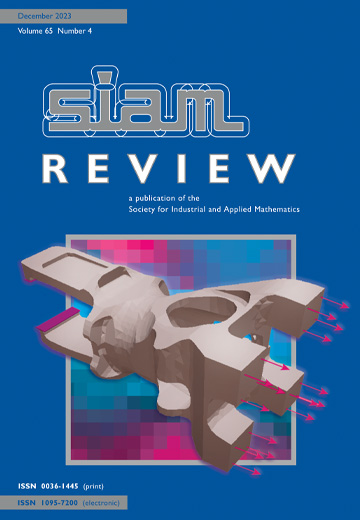Education
IF 6.1
1区 数学
Q1 MATHEMATICS, APPLIED
引用次数: 0
Abstract
SIAM Review, Volume 66, Issue 1, Page 147-147, February 2024.In this issue the Education section presents two contributions. The first paper, “Resonantly Forced ODEs and Repeated Roots,” is written by Allan R. Willms. The resonant forcing problem is as follows: find $y(\cdot)$ such that $L[y(x)]=u(x)$, where $L[u(x)]=0$ and $L=a_0(x) + \sum_{j=1}^n a_j(x) \frac{d^j}{dx^j}$. The repeated roots problem consists in finding $mn$ linearly independent solutions to $L^m[y(x)]=0$ under the assumption that $n$ linearly independent solutions to $L[y(x)]= 0$ are known. A recent article by B. Gouveia and H. A. Stone, “Generating Resonant and Repeated Root Solutions to Ordinary Differential Equations Using Perturbation Methods” [SIAM Rev., 64 (2022), pp. 485--499], discusses a method for finding solutions to these two problems. This new contribution observes that by applying the same mathematical justifications, one may get similar results in a simpler way. The starting point consists in defining operators $L_\lambda := \hat L -g(\lambda)$ with $L_{\lambda_0}=L$ for some $\lambda_0$ and of a parameter-dependent family of solutions to the homogeneous equations $L_\lambda[y(x;\lambda)]=0$. Under appropriate assumptions on $g$, differentiating this equality allows one to get solutions to problems of interest. This approach is illustrated on nine examples, seven of which are the same as in the publication of B. Gouveia and H. A. Stone, where for each example $g$ and $\hat L$ are appropriately chosen. This approach may be included in a course of ordinary differential equations (ODEs) as a methodology for finding solutions to these two particular classes of ODEs. It can also be used by undergraduate students for individual training as an alternative to variation of parameters. The second paper, “NeuralUQ: A Comprehensive Library for Uncertainty Quantification in Neural Differential Equations and Operators,” is presented by Zongren Zou, Xuhui Meng, Apostolos Psaros, and George E. Karniadakis. In machine learning uncertainty quantification (UQ) is a hot research topic, driven by various questions arising in computer vision and natural language processing, and by risk-sensitive applications. Numerous machine learning models, such as, for instance, physics-informed neural networks and deep operator networks, help in solving partial differential equations and learning operator mappings, respectively. However, some data may be noisy and/or sampled at random locations. This paper presents an open-source Python library (https://github.com/Crunch-UQ4MI) for employing a reliable toolbox of UQ methods for scientific machine learning. It is designed for both educational and research purposes and is illustrated on four examples, involving dynamical systems and high-dimensional parametric and time-dependent PDEs. NeuralUQ is planned to be constantly updated.
教育
SIAM 评论》,第 66 卷第 1 期,第 147-147 页,2024 年 2 月。 本期教育版块刊登了两篇论文。第一篇论文题为 "共振强迫 ODEs 和重复根",作者是 Allan R. Willms。共振强迫问题如下:求 $y(\cdot)$ 使 $L[y(x)]=u(x)$,其中 $L[u(x)]=0$ 和 $L=a_0(x)+\sum_{j=1}^n a_j(x) \frac{d^j}{dx^j}$。重复根问题包括在已知 $n$ 线性独立解 $L[y(x)]=0$ 的前提下,找到 $mn$ 线性独立解 $L^m[y(x)]=0$。B. Gouveia 和 H. A. Stone 最近发表的一篇文章 "使用扰动方法生成常微分方程的共振解和重复根解" [SIAM Rev., 64 (2022), pp.这篇新论文指出,通过应用相同的数学原理,我们可以用更简单的方法得到类似的结果。出发点包括定义算子 $L_\lambda := \hat L -g(\lambda)$,其中 $L_{\lambda_0}=L 为某个 $\lambda_0$,以及同质方程 $L_\lambda[y(x;\lambda)]=0$的解的参数依赖族。在对 $g$ 作适当假设的情况下,微分这个等式就能得到相关问题的解。我们用九个例子来说明这种方法,其中七个与 B. Gouveia 和 H. A. Stone 出版物中的例子相同,每个例子中的 $g$ 和 $\hat L$ 都经过适当选择。这种方法可以作为寻找这两类特殊 ODE 的解的方法纳入常微分方程(ODE)课程。本科生也可以用这种方法进行个人训练,作为参数变化的替代方法。第二篇论文题为 "NeuralUQ:神经微分方程和算子中不确定性量化的综合库",由邹宗仁、孟旭辉、Apostolos Psaros 和 George E. Karniadakis 发表。在机器学习领域,不确定性量化(UQ)是一个热门研究课题,由计算机视觉和自然语言处理中出现的各种问题以及对风险敏感的应用所驱动。许多机器学习模型,例如物理信息神经网络和深度算子网络,分别有助于求解偏微分方程和学习算子映射。然而,有些数据可能存在噪声和/或采样位置随机。本文介绍了一个开源 Python 库(https://github.com/Crunch-UQ4MI),用于在科学机器学习中使用可靠的 UQ 方法工具箱。该库专为教育和研究目的而设计,并通过四个例子进行了说明,涉及动力系统和高维参数与时间相关的 PDE。NeuralUQ 计划不断更新。
本文章由计算机程序翻译,如有差异,请以英文原文为准。
求助全文
约1分钟内获得全文
求助全文
来源期刊

SIAM Review
数学-应用数学
CiteScore
16.90
自引率
0.00%
发文量
50
期刊介绍:
Survey and Review feature papers that provide an integrative and current viewpoint on important topics in applied or computational mathematics and scientific computing. These papers aim to offer a comprehensive perspective on the subject matter.
Research Spotlights publish concise research papers in applied and computational mathematics that are of interest to a wide range of readers in SIAM Review. The papers in this section present innovative ideas that are clearly explained and motivated. They stand out from regular publications in specific SIAM journals due to their accessibility and potential for widespread and long-lasting influence.
 求助内容:
求助内容: 应助结果提醒方式:
应助结果提醒方式:


